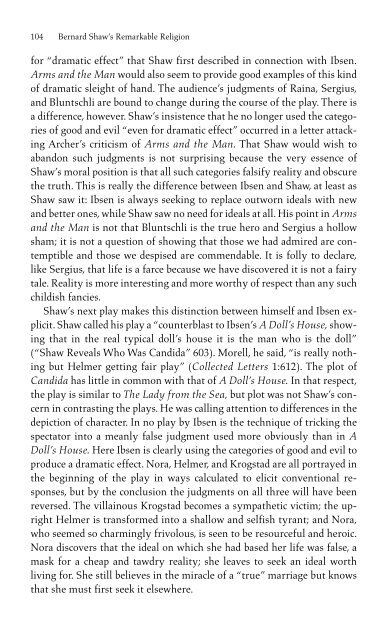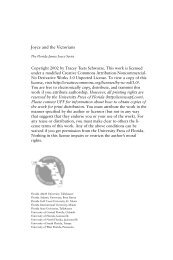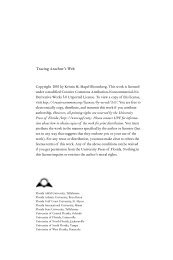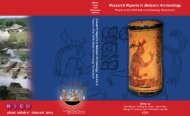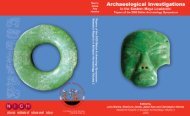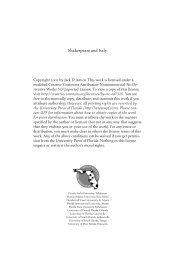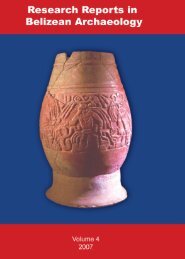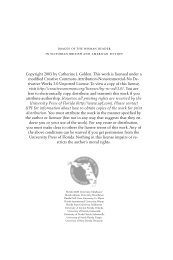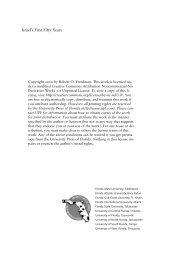Bernard Shaw's Remarkable Religion: A Faith That Fits the Facts
Bernard Shaw's Remarkable Religion: A Faith That Fits the Facts
Bernard Shaw's Remarkable Religion: A Faith That Fits the Facts
You also want an ePaper? Increase the reach of your titles
YUMPU automatically turns print PDFs into web optimized ePapers that Google loves.
104 <strong>Bernard</strong> Shaw’s <strong>Remarkable</strong> <strong>Religion</strong><br />
for “dramatic effect” that Shaw first described in connection with Ibsen.<br />
Arms and <strong>the</strong> Man would also seem to provide good examples of this kind<br />
of dramatic sleight of hand. The audience’s judgments of Raina, Sergius,<br />
and Bluntschli are bound to change during <strong>the</strong> course of <strong>the</strong> play. There is<br />
a difference, however. Shaw’s insistence that he no longer used <strong>the</strong> categories<br />
of good and evil “even for dramatic effect” occurred in a letter attacking<br />
Archer’s criticism of Arms and <strong>the</strong> Man. <strong>That</strong> Shaw would wish to<br />
abandon such judgments is not surprising because <strong>the</strong> very essence of<br />
Shaw’s moral position is that all such categories falsify reality and obscure<br />
<strong>the</strong> truth. This is really <strong>the</strong> difference between Ibsen and Shaw, at least as<br />
Shaw saw it: Ibsen is always seeking to replace outworn ideals with new<br />
and better ones, while Shaw saw no need for ideals at all. His point in Arms<br />
and <strong>the</strong> Man is not that Bluntschli is <strong>the</strong> true hero and Sergius a hollow<br />
sham; it is not a question of showing that those we had admired are contemptible<br />
and those we despised are commendable. It is folly to declare,<br />
like Sergius, that life is a farce because we have discovered it is not a fairy<br />
tale. Reality is more interesting and more worthy of respect than any such<br />
childish fancies.<br />
Shaw’s next play makes this distinction between himself and Ibsen explicit.<br />
Shaw called his play a “counterblast to Ibsen’s A Doll’s House, showing<br />
that in <strong>the</strong> real typical doll’s house it is <strong>the</strong> man who is <strong>the</strong> doll”<br />
(“Shaw Reveals Who Was Candida” 603). Morell, he said, “is really nothing<br />
but Helmer getting fair play” (Collected Letters 1:612). The plot of<br />
Candida has little in common with that of A Doll’s House. In that respect,<br />
<strong>the</strong> play is similar to The Lady from <strong>the</strong> Sea, but plot was not Shaw’s concern<br />
in contrasting <strong>the</strong> plays. He was calling attention to differences in <strong>the</strong><br />
depiction of character. In no play by Ibsen is <strong>the</strong> technique of tricking <strong>the</strong><br />
spectator into a meanly false judgment used more obviously than in A<br />
Doll’s House. Here Ibsen is clearly using <strong>the</strong> categories of good and evil to<br />
produce a dramatic effect. Nora, Helmer, and Krogstad are all portrayed in<br />
<strong>the</strong> beginning of <strong>the</strong> play in ways calculated to elicit conventional responses,<br />
but by <strong>the</strong> conclusion <strong>the</strong> judgments on all three will have been<br />
reversed. The villainous Krogstad becomes a sympa<strong>the</strong>tic victim; <strong>the</strong> upright<br />
Helmer is transformed into a shallow and selfish tyrant; and Nora,<br />
who seemed so charmingly frivolous, is seen to be resourceful and heroic.<br />
Nora discovers that <strong>the</strong> ideal on which she had based her life was false, a<br />
mask for a cheap and tawdry reality; she leaves to seek an ideal worth<br />
living for. She still believes in <strong>the</strong> miracle of a “true” marriage but knows<br />
that she must first seek it elsewhere.


